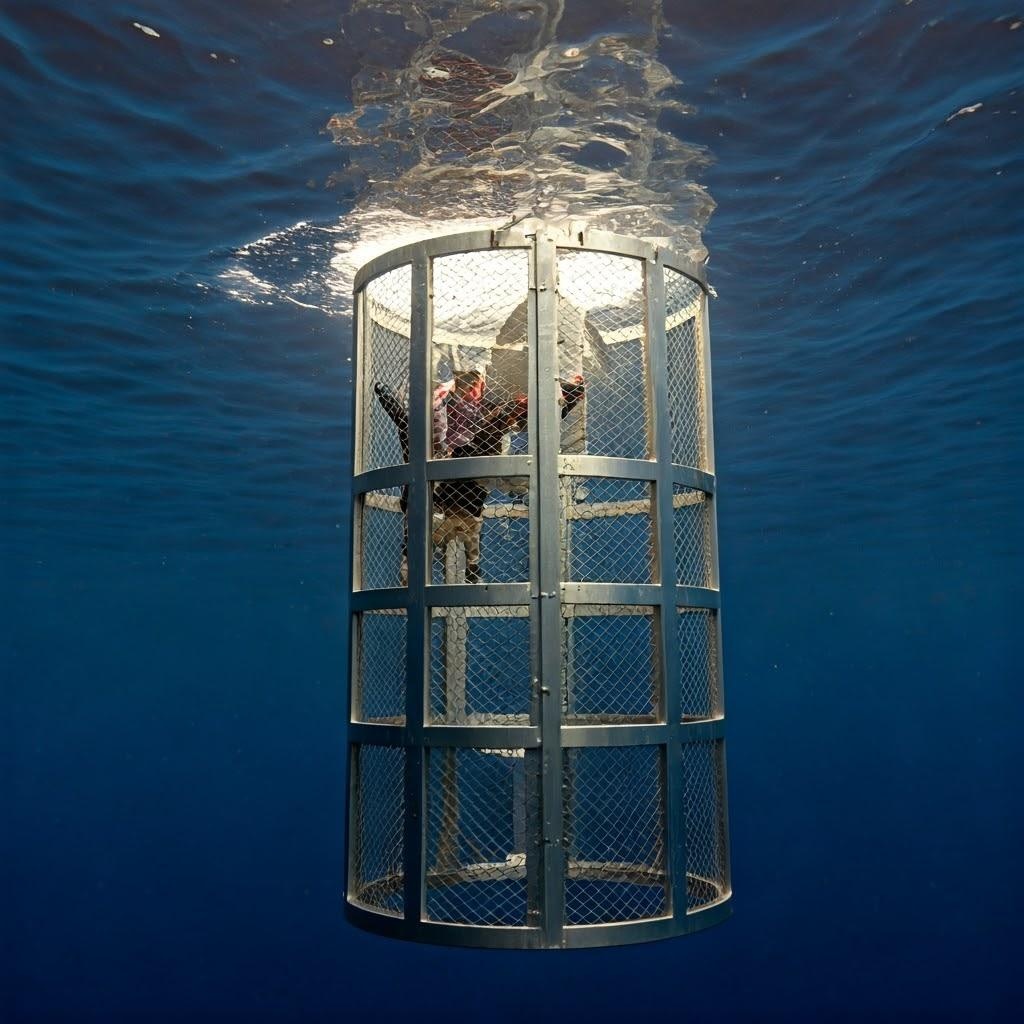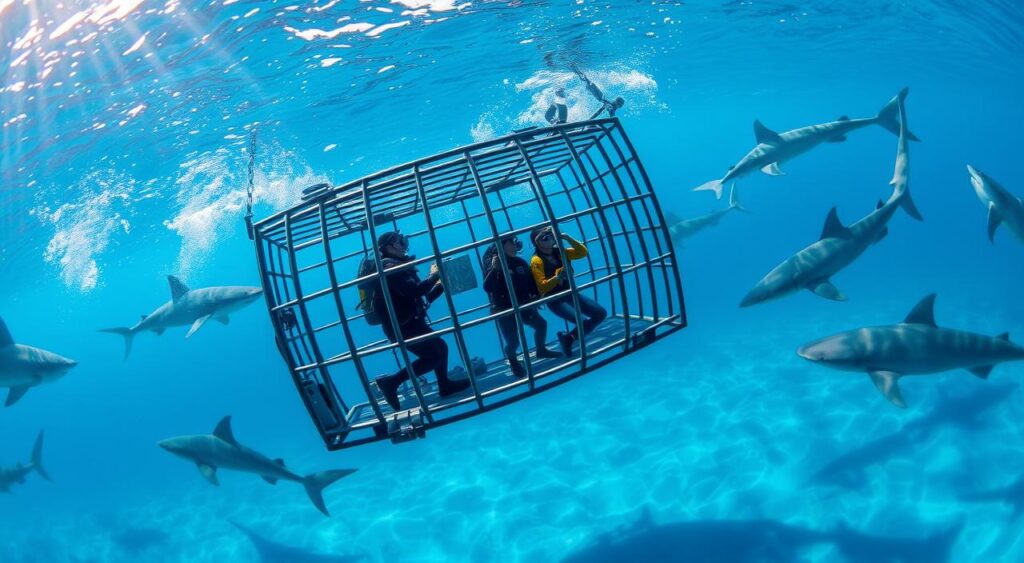Shark cage diving lets you see amazing ocean predators like great white sharks up close. It’s a safe way to meet these iconic sea creatures. This activity helps raise awareness about sharks and supports their protection.
By diving into shark cage adventures, you see these animals’ power and beauty. You’ll watch them hunt and interact with their surroundings. This experience can make you want to help protect sharks and their homes.
Table of Contents
The Origins of Shark Cage Diving
For years, people have been drawn to the thrill of seeing sharks up close. This fascination started with Rodney Fox, an Australian explorer. He changed how we see these powerful sea creatures.
Rodney Fox’s Pioneering Adventure
In 1963, Rodney Fox almost died from a shark attack off South Australia. He wanted to face his fear and share his love for sharks. So, Fox built the first shark cage in 1965.
He started public tours and filmed great whites underwater. This was a groundbreaking moment.
The Birth of a New Tourism Industry
Rodney Fox’s idea of shark cage diving started a new tourism trend. Soon, places like South Africa and Mexico joined in. Now, shark cage diving is a hit with thrill-seekers worldwide.
The story of shark cage diving begins with Rodney Fox. His bravery and love for sharks created a global phenomenon.
Understanding Shark Cage Diving

Shark cage diving is a thrilling experience that lets you see sharks up close. Divers or snorkelers go into the water in a metal cage. The cage is tied to a boat, so they can watch sharks in their home.
What is Shark Cage Diving?
Shark cage diving is a fun way to see sharks safely. You can see great white sharks, bull sharks, and tiger sharks in their natural setting. The cage holds up to six people at a time, making it a safe and exciting way to see these amazing animals.
Popular Destinations for Shark Cage Diving
- South Africa: Known for its abundant great white shark population, South Africa is one of the premier destinations for shark cage diving enthusiasts.
- Australia: Offering opportunities to encounter bull sharks and tiger sharks, Australia’s coastal regions have become popular shark cage diving hotspots.
- Mexico: The waters off the Baja California peninsula provide a chance to dive with great white sharks.
- The United States: Locations like California, Hawaii, and Florida attract visitors seeking to observe great white sharks and other species.
- The Bahamas: This tropical destination is renowned for its tiger shark diving experiences.
Shark cage diving operators go to places where sharks like to be, like near seal colonies. They use baits or chum to get the sharks close to the cage. This lets people see sharks in their natural home while staying safe.
| Destination | Shark Species | Water Temperature | Duration of Trips |
|---|---|---|---|
| South Africa | Great White Sharks | 9°C (48°F) to 20°C (68°F) | 2 to 3 hours |
| Australia | Bull Sharks, Tiger Sharks | 12°C (54°F) to 25°C (77°F) | 2 to 3 hours |
| Mexico | Great White Sharks | 16°C (61°F) to 22°C (72°F) | 2 to 3 hours |
| United States | Great White Sharks | 11°C (52°F) to 24°C (75°F) | 2 to 3 hours |
| The Bahamas | Tiger Sharks | 22°C (72°F) to 29°C (84°F) | 2 to 3 hours |
Shark cage diving tours are not just fun. They also teach you about sharks, their behavior, and why they’re important. This helps people understand and care for these amazing creatures.
The Role of Baiting and Chumming
Shark cage diving operators use baits and chum to attract sharks. Baiting means using whole fish like tuna as a lure. Chumming uses a mix of fish parts and oils to create a scent trail. These methods help sharks find the boats, but bait use is debated.
Some worry it might change shark behavior or increase risks of bad shark-human interactions.
Attracting Sharks with Baits and Chum
Studies show baiting and chumming can make shark encounters more likely. But, it raises questions about shark behavior and marine health. Rules have been set to help, like not feeding sharks directly and removing bait quickly.
The shark cage diving industry brings in tourism money. Yet, there’s a debate on shark baiting and shark chumming‘s effects on sharks. Finding a balance between exciting experiences and protecting marine life is a big challenge.
“The negative impact of baiting and feeding sharks may include a potential decline in biodiversity and the disruption of natural predator-prey dynamics in marine ecosystems.”
The shark cage diving industry is growing. Using baits and chum responsibly to attract sharks is a complex issue. It needs careful thought and ongoing research to protect sharks and marine life.
Safety Concerns and Regulations

Shark cage diving is seen as safe for interacting with sharks. But, there are worries about baiting and chumming. These practices might make sharks think humans are food. Coastal communities near diving spots are concerned about more shark encounters.
However, there’s not much proof that baiting leads to more shark bites. The shark cage diving industry has stepped up to address these concerns. Now, feeding sharks directly is banned. Operators must quickly remove baits when sharks get close to the cage.
These rules help keep sharks’ natural behavior intact. They also reduce the chance of sharks seeing humans as food.
Addressing Fears of Sharks Associating Humans with Food
The fear of sharks linking humans with food is real. But, shark cage diving has a great safety record. No one has died in a shark cage diving accident. There’s only one case of a shark getting caught and bleeding to death.
In 2005, a great white shark attacked a British tourist. But, he survived thanks to the boat captain. Shark cage diving companies work with marine groups to support shark conservation. They follow strict safety rules and make sure divers are ready.
By following strict safety rules, shark cage diving is both exciting and safe. It also helps people understand and care for sharks.
shark cage diving
Shark cage diving lets you see sharks up close and personal. You’re safe in a metal cage while sharks swim just feet away. It’s a chance to learn about these animals and help conservation efforts.
Rodney Fox started shark cage diving after surviving a shark attack in 1963. His company, Rodney Fox Shark Expeditions, has been leading tours for over 50 years. Now, his son and a business partner run it.
The four-day trip includes dives from both the sea floor and surface cages. You’ll learn about shark ecology and conservation onboard. The crew even knows some sharks by name, like “Coco Pops” and “Imax.”
Shark cage diving isn’t just in Australia. Places like Fiji and the Bahamas offer exciting shark encounters. Beqa Lagoon in Fiji and Tiger Beach in the Bahamas are just a few spots.
Looking for an adrenaline rush or a deeper understanding of sharks? Shark cage diving experiences around the world are unforgettable. They let you connect with the ocean in a unique way.
“The crew mentioned that sharks sometimes manage to catch the bait during fishing demonstrations off the boat.”
Conservation Benefits of Shark Tourism
Shark tourism, especially shark cage diving, offers big benefits for conservation. It lets people see sharks up close, changing how we see them. This shift moves us from fear to respect and care for these creatures.
Promoting Shark Awareness and Protection
Seeing sharks in their natural habitat through cage diving can change our views. It makes us understand and respect these animals more. This understanding leads to more support for protecting sharks and their homes.
Providing Economic Incentives for Conservation
Shark tourism brings in money, which helps protect sharks. It supports local jobs and helps keep shark populations safe. This shows sharks are valuable for tourism, pushing for their conservation.
| Shark Tourism Conservation Benefits | Key Highlights |
|---|---|
| Promoting Shark Awareness and Protection |
|
| Providing Economic Incentives for Conservation |
|
Shark tourism can start a new chapter in protecting these vital ocean animals. It helps keep our oceans healthy for future generations.
Ethical Considerations in Shark Tourism
The rise of ethical shark tourism brings up key ethical issues. Badly run shark tourism can mess with sharks’ natural ways, hurting them and the sea. It’s vital to think about how we interact with these amazing animals.
Baiting and chumming to get sharks to come near is a big worry. It might make sharks see humans as food, which is risky. Responsible shark tourism operators need to care for the animals and keep them safe, while still giving people a great experience.
Following rules, not feeding sharks directly, and focusing on education and conservation are essential. 54% of tourists say animal welfare is key in wildlife tourism. And 17% of bad animal encounters involve touching wildlife.
By focusing on shark welfare and good practices, shark tourism can help a lot. It helps sharks and keeps the sea healthy. This is good for everyone.
“Responsible shark tourism operators must prioritize the welfare of the animals and minimize any negative impacts, while also providing participants with a safe and enriching experience.”
In summary, as shark tourism gets more popular, we must all focus on ethical and sustainable ways. Working together, we can make sure shark encounters are full of wonder, learning, and help for the sea for years to come.
The Rise of Cage-Free Shark Diving
Shark cage diving has long been a thrilling way to see sharks. Now, a new trend, cage-free shark diving, is gaining popularity. Led by adventurers like Juan Oliphant and Ocean Ramsey, it aims to show sharks in a new light. They want to change how we see these creatures, from monsters to magnificent beings.
Breaking Barriers and Changing Perceptions
Divers now dive without cages, getting closer to sharks. This new way of diving creates a deeper connection with these amazing animals. It also helps educate people and protect sharks around the world.
A 2013 study found shark-watching tourism brings in about USD 314 million yearly. It’s expected to grow to USD 780 million in 20 years. In Australia, a 2017 study showed shark diving brings in around USD 25.5 million yearly.
Pioneers of Cage-Free Shark Diving
The pioneers of cage-free shark diving are changing how we see sharks. They show us sharks in a new light, as majestic and complex creatures. They prove that sharks are not just killers, but also amazing beings.
“The sharks are not the monsters here, we are. We’ve demonized them, and now we’re finally seeing them for what they truly are – magnificent, complex creatures that deserve our respect and protection.”
The cage-free shark diving movement is growing fast. It’s helping us understand and appreciate sharks more. By getting closer to sharks, these pioneers are changing how we see them. They’re also leading important efforts to protect these ocean wonders.
